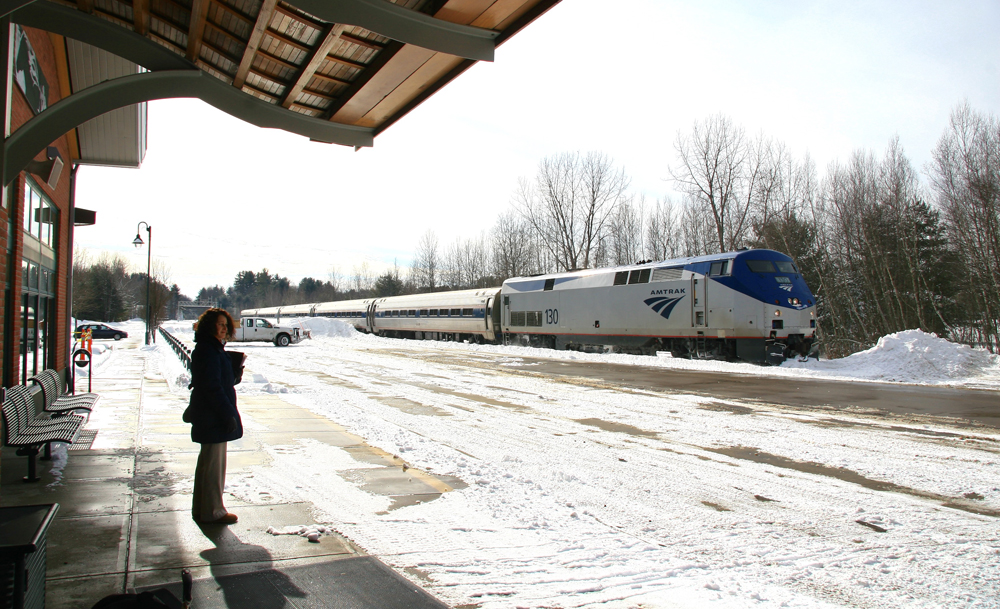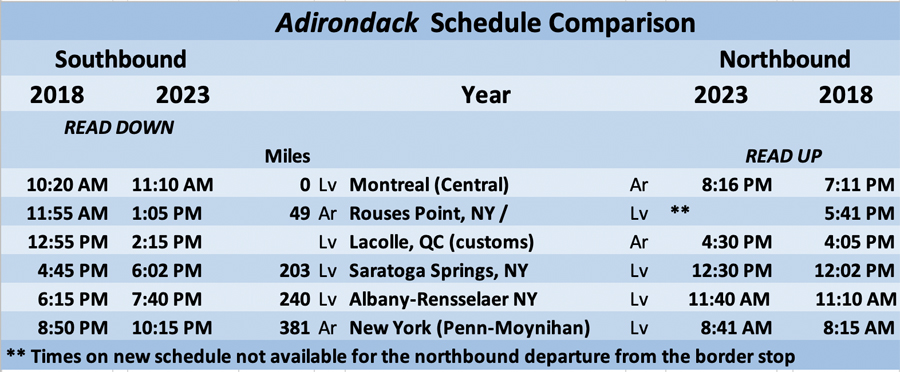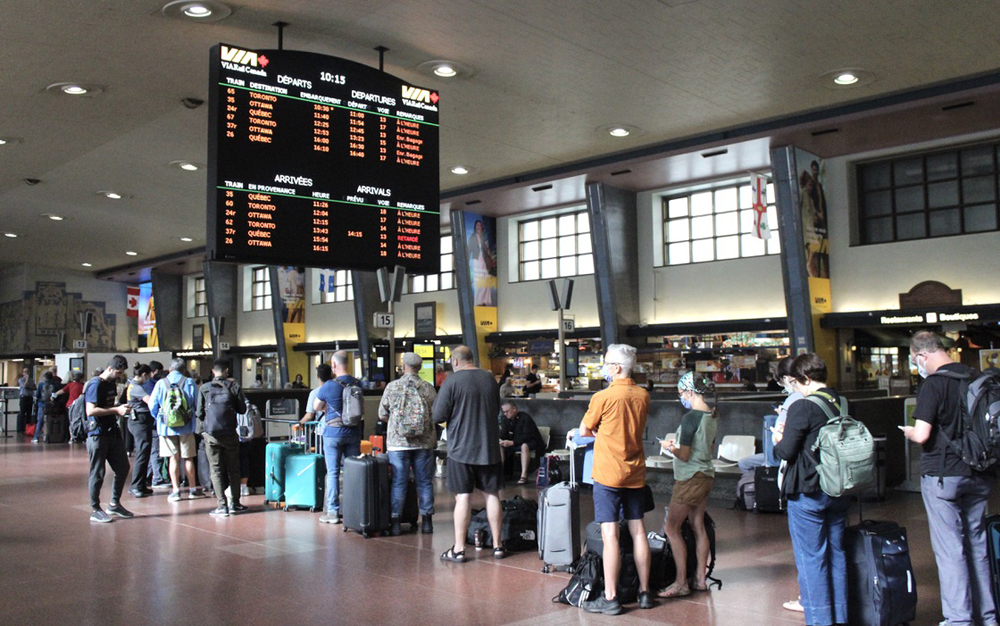
NEW YORK — Following intense pressure from New York politicians, Amtrak has started selling tickets for travel on the New York-Montreal Adirondack, which will resume operation April 3 northbound and April 4 southbound.
Ticket sales began Monday, March 20. It is the last route to be reinstated following widespread suspensions that took place in March 2020 as a result of the COVID-19 pandemic.
The service resumption date was announced March 10 by U.S. Sens. Charles Schumer and Kirsten Gillibrand (both D-N.Y.) [see “Amtrak to resume Adirondack service …,” Trains News Wire, March 11, 2023].
A half-hour of running time has been added in both directions between Montreal Central Station and the first U.S. stop, Rouses Point, N.Y., compared with Amtrak schedules before the train was dropped (see below).

Deteriorating track conditions likely played a role in the complications Amtrak encountered in restoring service. Another 10 minutes was also added to what was previously an hour-long customs stop. The lengthened trip time also triggered a later southbound departure from Montreal to allow the U.S.-based operating crew enough federally mandated overnight rest if the northbound train is late.
Unlike the New York-Toronto Maple Leaf, VIA Rail Canada employees do not operate or staff the train, but the company does book tickets on its website.
A Canadian source tells News Wire that agreements have been made to improve track conditions, though a Canadian National spokesman over the weekend would only say, “CN and Amtrak have been in discussions to restore service between New York and Montreal [and we are] working closely with [Amtrak] to meet the partner’s desired timelines.”
While the press release says the Adirondack will have cafe service, Amtrak spokesman Jason Abrams confirmed to News Wire without further explanation that business class is not being offered. It is also unclear whether a summer-only stop at Port Kent, N.Y., will be reinstated now that ferries have reportedly been scrapped that previously provided service from there across Lake Champlain to Burlington, Vt.
Amtrak and New York’s DOT declined to answer with any specificity News Wire questions during the past three years why the train was not at least short-turned at Plattsburgh, N. Y., to serve rural communities, or if any progress has been made in establishing customs pre-clearance at Montreal’s Central Station.
There is not adequate trackage to turn equipment at either Plattsburgh or Rouses Point, N.Y. However, if New York state and Amtrak had been willing to restart the Adirondack on a slightly modified schedule before Canadian border-crossing restrictions were relaxed, a push-pull operation might have been able to run with a cab car or second locomotive. A Thruway bus at one time connected Montreal with the state-sponsored Vermonter at St. Albans, Vt. Though not ideal compared to the train’s one-seat ride, buses generally clear customs at highway border crossings in about 15 minutes.
A sequestered pre-clearance facility at Pacific Central Station in Vancouver, British Columbia, has eliminated border delays on the Amtrak Cascades, and a treaty ratified by the U.S. and Canada in late 2016 apparently now permits that on the Adirondack’s route. Yet no progress has been reported in establishing that capability at Montreal.

“There is no easy way to cordon off an area at Montreal’s station, and it will be expensive,” explains Ed Courtemanch, the now-retired Amtrak senior director of service planning. He was tasked with exploring the feasibility of pre-clearance in 2017 before he left the company after more than 45 years. Reached by phone Monday, he tells News Wire that the initiative was driven then by Vermont’s desire to extend the Vermonter.
“If pre-clearance were established, we would have to run a sterile corridor — no stops in Canada, which is what the Cascades do. The question then, and probably now, is who would pay for it,” Courtemanch adds.
The Adirondack’s sole intermediate stop in Canada is at St. Lambert, a suburban station across the St. Lawrence River from Montreal, but eliminating what is now more than an hour’s border pause would make the service more attractive.
The lawmakers’ press statements praised the service reinstatement, with Gillibrand noting, “the line’s years-long closure has been economically harmful to many communities along its route.”
Amtrak President Roger Harris acknowledged “the strong support and advocacy of Senators Schumer and Gillibrand, Congresswoman [Elise] Stefanik [R-NY] and our partners at NYSDOT, VIA Rail, and the Federal Railroad Administration; we’re proud to restore service to one of the most popular trains in the Northeast.”














Have to speak up about the pre-clearance for the Cascades in Vancouver, BC. US Customs and Border Protection is indeed at Pacific Central Station in a secure area. Bags go through the x-ray machine, and you board the train, which is also in a secured area. Train travels non-stop to the US/Canada border. One across the border at Blaine, the train stops (adjacent to the long-closed Blaine Station), and Border agents walk to the train from the booths at the highway crossing. They then get on the train, walk through collecting your declaration form- which you filled out at Vancouver prior to pre-clearance, but not collected until Blaine. And twenty minutes later (more or less depending on the passenger load), the agents leave the train, and it continues south to Seattle.
Why does this second stop for CBP at the border? I can only summize, “Because they can.”
Please note that the northbound Cascades *does not stop* at the border; all Canadian Border Services Agency checks are done in Vancouver, none of this stopping in White Rock, BC, for checks.
It appears with the northbound Adirondack once customs as completed their work the train can depart at any time. Southbound appears to be operating according to timetable authority.
If Southern Railway System were operating ‘The Adirondack’, Saratoga Springs, NY would likely be the designated meal stop in both directions at midpoint. The symbol “||” would be placed by Saratoga Springs’ name in the timetable with the footnote, “Boxed meals are available on notice to conductor.”
The meal palatable to everyone would be three pieces of fried chicken, crinkled French fries and roll. All of the food is cooked in lard and served with 8 oz bottle of ice-cold Coca-Cola® that fills the sinuses and then expels through the nostrils, ears and eyes. [I know this gives away my age.]
If you consult Amtrak reservations the actual northbound running time allowed for Rouses Point to Montreal is 3 hours 43 minutes northbound with the Canadian border work included, eg. 433pm to 816pm. Southbound is better. The pure run time montreal to RP is 1 hour 55 minutes, 1110am to 105 pm, but by the time US border work is done there is a layover of over an hour for a true time with the CPB stop delay of 3 hours 5 minutes. The net difference is over half an hour better than attained going north.
In all cases this is way too long. In 2016 the over the road time Montreal to RP was 1 hour 35 minutes. The track distance is only 49 miles.
An hour-long custom stop? I have crossed the US – Canadian border countless times, by rail, by air, by automobile and by bicycle. Customs/ immigration took anywhere from a couple of minutes to around a half hour, the latter because one of our party had left her Province de Quebec identity card behind in Michigan.
On a flight from London to Milwaukee, changing at Toronto, I filled out a card while the plane crossed the Atlantic Ocean. That was it. Only airline employees looked at my passport, neither Canada Border Security nor USA Customs/ Immigration
Doesn’t anyone know that commuter buses routinely cross the border during rush hour? Or at least did before COVID. People got on the bus in Windsor and got off the bus in Detroit in the morning, the reverse in the afternoon. Hardly any different than a commuter bus between Detroit and a suburb on the Michigan side.
Come on folks, the US – Canada border is as porous as any. Why pick on trains? Why is it that the only by rail is crossing the border a hassle?
Just for kicks I trolled airline and Amtrak schedules comparing New York to Toronto by Amtrak, WestJet (Delta partner) and Amtrak. Times, fares and number of daily schedule selections. It’s just astounding how poor the train alternative is. Rail passengers have to disembark at the border for inspection. What is this, going from Poland to Soviet Russia in 1937? No airline passenger traveling between USA and Canada would be treated that way.
The customs stop at the border on the railroad is almost as long as the end-to-end flight from Newark or LaGuardia to Pearson.
Nor was I treated that way the last time I crossed the border by rail, London (Ontario) to Lapeer (Michigan) in 1986.
Rail is dead.